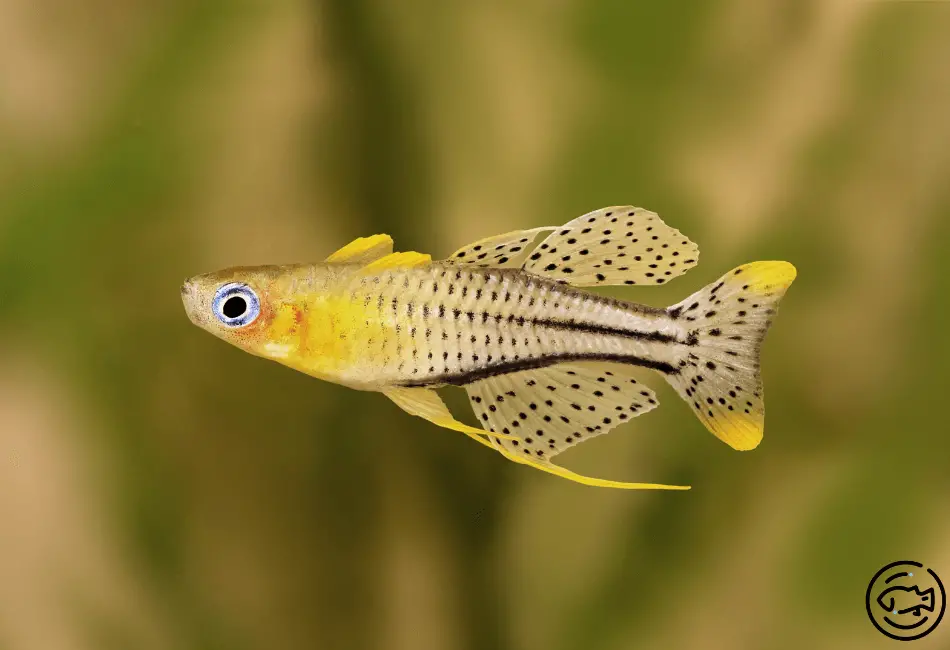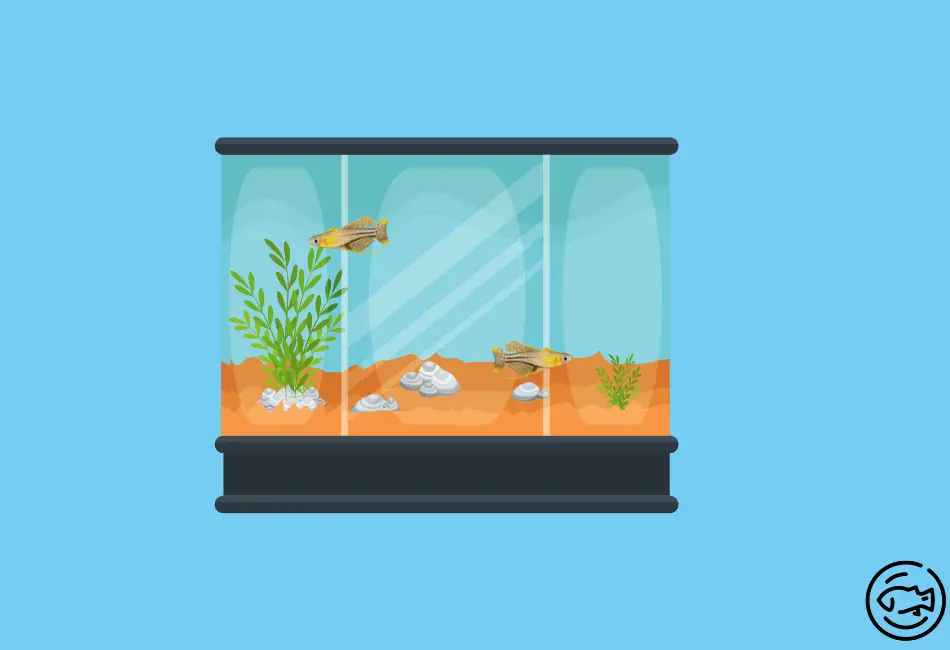The Pseudomugil Gertrudae, also known as the Gertrude Rainbow Fish, is a vibrant member of the Rainbowfish family that is predominantly found in the Northern regions of Australia, Indonesia, and New Guinea.
Despite being tiny in size, this species boasts a bright coloration that mesmerizes everyone.
While it is not widely distributed and only inhabits streams within about five specific areas, it is frequently kept in freshwater aquariums due to its placid temperament and popularity among fish enthusiasts.
The Gertrude Fish, also known as the Spotted Blue Eye Rainbowfish, boasts an elongated, compressed body with semi-transparent blueish-silver hues that may have a golden-yellow sheen.
Its swim bladder and two dorsal fins of different sizes are visible. The pectoral fins’ tips are often vibrant yellow, orange, or orangey-red, while the other fins are typically lined with white.
The anal, dorsal, and tail fins can range from transparent to white, silvery-grey, or yellow, adorned with oblong or rounded dark spots scattered throughout.
The body scales exhibit a striking latticework pattern bordered in black, with most scales bearing a spot that runs continuously from the start of the first dorsal fin to the caudal peduncle.
These fish exhibit significant body size, finnage size and shape, and coloration variations.
Overview

The Gertrude fish, also known as the spotted ‘blue-eye’ fish, earned its name from its distinct characteristics.
This is due to its small size, with bright fluorescent blue eyes that are very visible, making it easy to spot. The male has an overall yellow-green color, while the female has an orange blush, which is deeper at the tail.
The male has bright yellow wings resembling pectoral fins, and both sexes have spots, with males being more colorful. The dorsal and pectoral fins are feather-like, while the female has shorter fins.
The males exhibit fan-like dorsal and anal fins with maturity, and they grow to just a little over an inch in length. Male Gertrude Rainbowfish love to assert their dominance by flaring their extended dorsal, pectoral, and anal fins and obtain much brighter coloration once matured.
Behavior
Gertrude fish is a docile species, making it unsuitable for a community aquarium where it may struggle to compete for resources due to its timid nature.
Additionally, Gertrude fish have a tendency to jump when startled, much like some humans. It is recommended that these species be kept alone or alongside similarly sized and tempered fish.
Although Gertrude fish are naturally shoaling and tend to move in groups, they don’t need to swim in the same direction. Keeping at least 8-10 Gertrude fish together can help reduce nervousness and mimic their natural habitat more effectively.
Habitat

Gertrude fish is typically found in the shallow, marginal zones of freshwater habitats such as small creeks, swamps, marshes, rainforest streams, lily lagoons, backwaters, slow-moving streams, and overflows adjacent to larger rivers.
In the wild, they tend to inhabit waters less than 60cm (2ft) deep and have a pH between 5.2 and 6.7. These fish also prefer to be around sunken trees in densely grown areas and waters with floating plants to escape from predators.
If you want to keep Gertrude fish in your aquarium, then it is best to mimic their natural environment, which can be achieved by creating a similar setting with floating plants & vegetation growing up from the substrate.
The water temperature in the tank should be between 23-30 degrees, and water hardness should be between 80 and 210 ppm. Gertrude fish cannot tolerate significant fluctuations in water parameters and require well-oxygenated water.
It is important to note that Gertrude fish are peaceful and tend to thrive better in a waterway with vegetation. They are not suitable for immature aquariums and prefer muddy water bottoms and clear water tops.
Breeding

The Gertrude fish is a fascinating and undemanding species, especially during spawning. They are known for their continuous spawning, which typically occurs in the late morning and early afternoon.
During this time, the male selects a spawning location and woos the female by rapidly swimming back and forth in front of the spot, displaying his fully erect dorsal and anal fins to impress her.
In an aquarium setting, the spawning process differs from their natural habitat. To facilitate successful breeding, it is essential to recreate a suitable environment with spawning mops or densely grown java moss. These mops can be made from different materials, but green nylon yarn is preferable as it closely resembles grass. As bottom spawners, placing the mops at the bottom of the tank is best.
Adult Gertrude fish do not feed on their young, so they commonly find fry in the tank if they are bred alone. A healthy female Gertrude can lay up to 10 eggs per week, and their fry overgrows, maturing in about three months. With an average lifespan of only one year, Gertrude fish are often considered annual.
Diet

Before delving into the taste of Gertrude fish and whether it’s suitable for consumption, it’s important to understand their diet. These fish are classified as omnivorous and require a balance of high-quality dry and flake foods along with small live or frozen meaty foods for optimal health and coloration.
Given their shy nature, it’s crucial to ensure that they receive enough food and are not overshadowed by more aggressive eaters. Their diet mainly consists of small invertebrates, including crustaceans, insect larvae, small worms, zooplankton, and leaf insects.
In an aquarium, their food can be supplemented with crushed flake, phytoplankton, and other suitable alternatives. Pellets should be small enough for their small mouths. Looking for top-quality pans for cooking fish? Check out these recommendations.
Water Parameters
Gertrude fish thrives best in fresh or brackish water environments, although they are primarily found in freshwater habitats due to the abundance of decaying plants.
When keeping them in an aquarium, it is essential to maintain a well-cycled, well-filtered, slightly acidic, and well-oxygenated water environment. It is also crucial to avoid fluctuations in water chemistry as this can adversely affect the fish.
Due to their small size, Pseudomugil gertrudae can be kept in shoals of 6-8 in aquariums as small as 10 gallons (37.85 liters). However, larger tanks are recommended for ensuring consistent water chemistry. A dark-colored sand or gravel substrate can be used to mimic their natural environment, with dried leaves and branches placed on the surface.
Diseases
Rainbowfish, including the Gertrude species, are more susceptible to skin flukes, bacterial infections, ichthyobodo infections, and parasitic infections caused by worms, protozoa, and other harmful pathogens.
Poor water quality, overcrowding, and unfavorable environmental conditions leading to stress can cause these infections.
To avoid infections, aquarium owners must maintain the water requirements such as pH, temperature, and hardness within the recommended range for the particular rainbowfish species.
Keeping a spotless and well-maintained tank with regular water changes and an efficient filtration system is crucial in preventing infections or diseases.
Conclusion
The Gertrude Fish, also known as the Spotted Blue Eye Rainbowfish, is a vibrant and colorful species predominantly found in the Northern regions of Australia, Indonesia, and New Guinea. Despite its small size, this species boasts an eye-catching coloration that mesmerizes everyone.
Gertrude Fish are docile species and unsuitable for community aquariums. They are peaceful and tend to thrive better in a waterway with vegetation, and are not suitable for immature aquariums as they prefer muddy water bottoms with clear water tops.
Their diet consists of a balance of high-quality dry and flake foods and small live or frozen meaty foods for optimal health and coloration.
Breeding Gertrude Fish in an aquarium setting is possible, and they are known for their continuous spawning.
The Gertrude Fish is a fascinating and undemanding species that can bring color and vibrancy to any aquarium.




[…] Gertrude Fish – Overview, Behavior, Diet, & More! […]